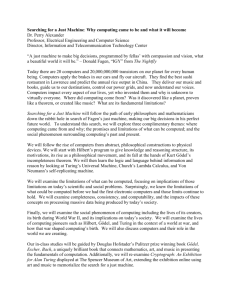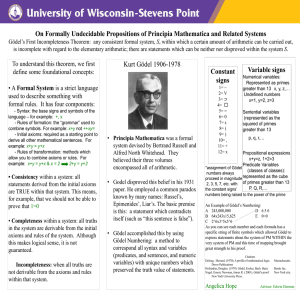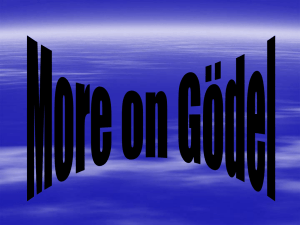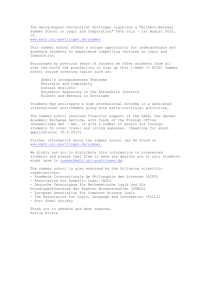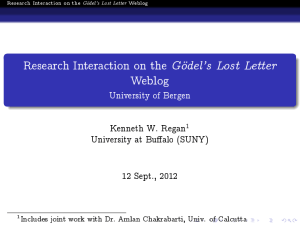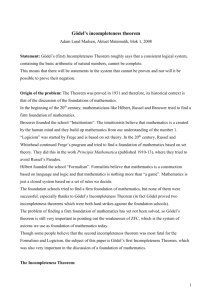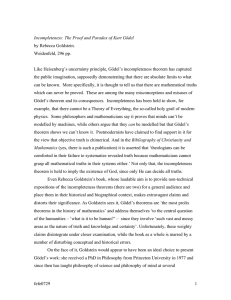Excerpt from The History of Mathematics and Human Civilization
advertisement
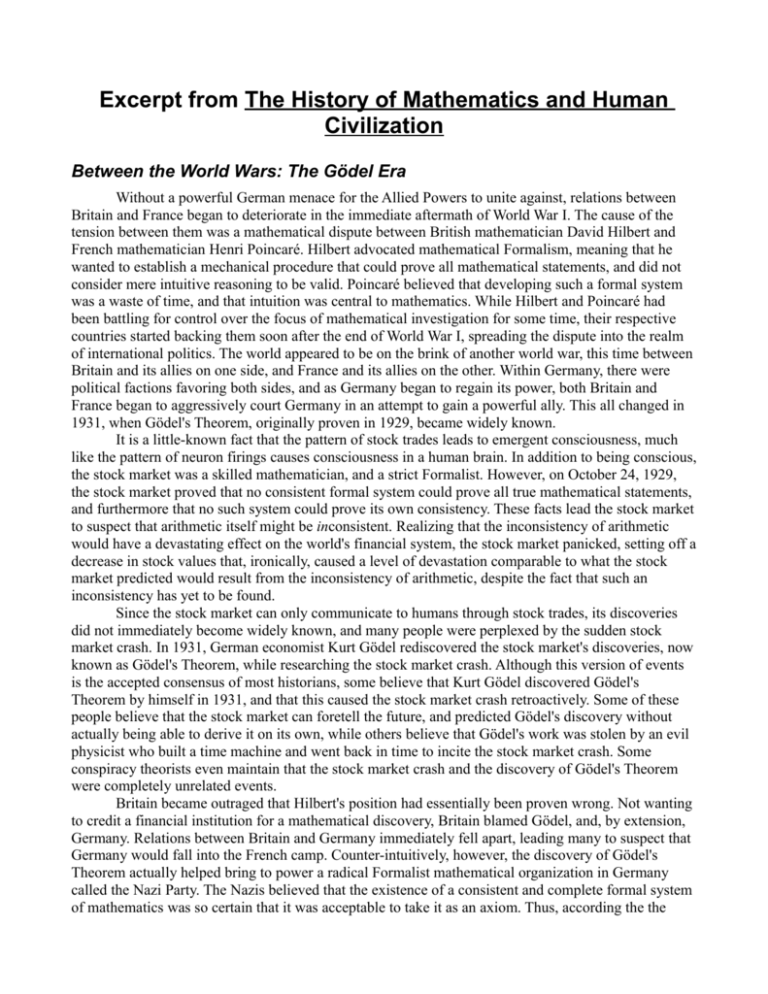
Excerpt from The History of Mathematics and Human Civilization Between the World Wars: The Gödel Era Without a powerful German menace for the Allied Powers to unite against, relations between Britain and France began to deteriorate in the immediate aftermath of World War I. The cause of the tension between them was a mathematical dispute between British mathematician David Hilbert and French mathematician Henri Poincaré. Hilbert advocated mathematical Formalism, meaning that he wanted to establish a mechanical procedure that could prove all mathematical statements, and did not consider mere intuitive reasoning to be valid. Poincaré believed that developing such a formal system was a waste of time, and that intuition was central to mathematics. While Hilbert and Poincaré had been battling for control over the focus of mathematical investigation for some time, their respective countries started backing them soon after the end of World War I, spreading the dispute into the realm of international politics. The world appeared to be on the brink of another world war, this time between Britain and its allies on one side, and France and its allies on the other. Within Germany, there were political factions favoring both sides, and as Germany began to regain its power, both Britain and France began to aggressively court Germany in an attempt to gain a powerful ally. This all changed in 1931, when Gödel's Theorem, originally proven in 1929, became widely known. It is a little-known fact that the pattern of stock trades leads to emergent consciousness, much like the pattern of neuron firings causes consciousness in a human brain. In addition to being conscious, the stock market was a skilled mathematician, and a strict Formalist. However, on October 24, 1929, the stock market proved that no consistent formal system could prove all true mathematical statements, and furthermore that no such system could prove its own consistency. These facts lead the stock market to suspect that arithmetic itself might be inconsistent. Realizing that the inconsistency of arithmetic would have a devastating effect on the world's financial system, the stock market panicked, setting off a decrease in stock values that, ironically, caused a level of devastation comparable to what the stock market predicted would result from the inconsistency of arithmetic, despite the fact that such an inconsistency has yet to be found. Since the stock market can only communicate to humans through stock trades, its discoveries did not immediately become widely known, and many people were perplexed by the sudden stock market crash. In 1931, German economist Kurt Gödel rediscovered the stock market's discoveries, now known as Gödel's Theorem, while researching the stock market crash. Although this version of events is the accepted consensus of most historians, some believe that Kurt Gödel discovered Gödel's Theorem by himself in 1931, and that this caused the stock market crash retroactively. Some of these people believe that the stock market can foretell the future, and predicted Gödel's discovery without actually being able to derive it on its own, while others believe that Gödel's work was stolen by an evil physicist who built a time machine and went back in time to incite the stock market crash. Some conspiracy theorists even maintain that the stock market crash and the discovery of Gödel's Theorem were completely unrelated events. Britain became outraged that Hilbert's position had essentially been proven wrong. Not wanting to credit a financial institution for a mathematical discovery, Britain blamed Gödel, and, by extension, Germany. Relations between Britain and Germany immediately fell apart, leading many to suspect that Germany would fall into the French camp. Counter-intuitively, however, the discovery of Gödel's Theorem actually helped bring to power a radical Formalist mathematical organization in Germany called the Nazi Party. The Nazis believed that the existence of a consistent and complete formal system of mathematics was so certain that it was acceptable to take it as an axiom. Thus, according the the Nazis, the negation of Gödel's Theorem is just as well established as Gödel's Theorem itself. A well known result in mathematics is that if one assumes two contradictory statements, it is possible to prove any other statement, whether true or false. The Nazis recognized this, and maintained that such inference was legitimate. Telling people that they could easily prove anything to be true turned out to be wildly popular, and the German people voted the Nazi Party into power. The ability to prove anything was also popular internationally, with the result that many countries, notably Italy, Japan, the Soviet Union, and Austria, became allied with Germany after the Nazi rise to power. This also helped bring the pro-German faction to victory in the Spanish Civil War. However, Poincaré was upset by the rabid mathematical Formalism upheld by the Nazis, so Germany's relationship with France deteriorated. Hilbert was not pleased with the Nazi's assertion that math was inconsistent, so the strict Formalism advocated by the Nazis did nothing to improve their relationship with Britain. Relations between Britain and Germany worsened still further when Nazi mathematician Adolf Hitler published Hitler's Theorem: Kill Jews. (proof: Gödel's Theorem is true and Gödel's Theorem is false. Therefore kill Jews. Q.E.D.). This caused the British government to adopt a solidly anti-German foreign policy at the urging of the ghost of David Hume, who insisted that an “ought” could never be derived from an “is”, even given contradictory “is” statements. The Nazis were not convinced by the ghost of David Hume's reasoning and in September 1939, responded by publishing Hitler's Second Theorem: Invade Poland, causing the world to plunge into war once more.
